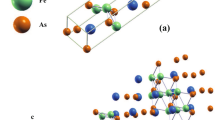Abstract
WE have been investigating the magnetic properties of a series of polynuclear complexes of the first-row transition elements. Following the procedure of Kambe1 and Abragam2, the general interaction between the two metal ions in a binuclear complex may be formulated as  , where J is the exchange interaction, s1 and s2 are the spins of the two metal ions, and
, where J is the exchange interaction, s1 and s2 are the spins of the two metal ions, and  is the Hamiltonian for the system. In the case of a binuclear chromium complex, this leads to the following expression for the atomic susceptibility per ion (χa):
is the Hamiltonian for the system. In the case of a binuclear chromium complex, this leads to the following expression for the atomic susceptibility per ion (χa):  . where K = g2Nβ2/3K; x = J/KT and N(α) is the high-frequency contribution to the susceptibility. Fig. 1 shows the calculated and experimental curves, for the susceptibilities of two such two such chromium complexes, between liquid-nitrogen and room temperatures. The value of K was taken such that N (α) was about 50 × 10−6 C.G.S. units as, from, spectral measurements, the nearest quartet-level for which interaction could occur was of the order of 15,000 cm.−1. The values of J, g and N(α) obtained are contained in Table 1. These values are of a similar order to those obtained by Kambe1 in the interpretation of Welo's data on some trinuclear complexes of chromium. The increase in interaction in the mono-bridged complexes may be due to the fact that the metal–oxygen–metal angle is not restricted, as in the diol.
. where K = g2Nβ2/3K; x = J/KT and N(α) is the high-frequency contribution to the susceptibility. Fig. 1 shows the calculated and experimental curves, for the susceptibilities of two such two such chromium complexes, between liquid-nitrogen and room temperatures. The value of K was taken such that N (α) was about 50 × 10−6 C.G.S. units as, from, spectral measurements, the nearest quartet-level for which interaction could occur was of the order of 15,000 cm.−1. The values of J, g and N(α) obtained are contained in Table 1. These values are of a similar order to those obtained by Kambe1 in the interpretation of Welo's data on some trinuclear complexes of chromium. The increase in interaction in the mono-bridged complexes may be due to the fact that the metal–oxygen–metal angle is not restricted, as in the diol.
This is a preview of subscription content, access via your institution
Access options
Subscribe to this journal
Receive 51 print issues and online access
$199.00 per year
only $3.90 per issue
Buy this article
- Purchase on Springer Link
- Instant access to full article PDF
Prices may be subject to local taxes which are calculated during checkout
Similar content being viewed by others
References
Kambe, H., J. Phys. Soc. Japan, 5, 48 (1950).
Yvon, J., Horrowitz, J., and Abragam, A., Rev. Mod. Phys., 25, 165 (1953).
Powell, H. M., and Ewens, R. V. G., J. Chem. Soc., 286 (1939).
Wessel, G. J., and Ijdo, D. J. W., Acta Cryst., 10, 466 (1957).
Michaelis, L., and Granick, S., J. Amer. Chem. Soc., 65, 481 (1943).
Gaines, A., Hammett, L. P., and Walden, G. H., J. Amer. Chem. Soc., 58, 1668 (1936).
Figgis, B. N., and Martin, R. L., J. Chem. Soc., 3837 (1956).
Bleaney, B., and O'Brien, M. C. M., Proc. Phys. Soc., 69, B, 1216 (1956).
Author information
Authors and Affiliations
Rights and permissions
About this article
Cite this article
EARNSHAW, A., LEWIS, J. Magnetic Properties of Some Binuclear Complexes of Chromium and Iron. Nature 181, 1262–1263 (1958). https://doi.org/10.1038/1811262a0
Issue Date:
DOI: https://doi.org/10.1038/1811262a0
This article is cited by
-
Chromium(III)-Oxyanion Systems
Nature (1961)
Comments
By submitting a comment you agree to abide by our Terms and Community Guidelines. If you find something abusive or that does not comply with our terms or guidelines please flag it as inappropriate.



